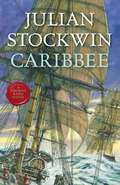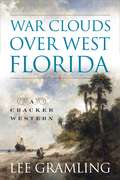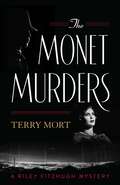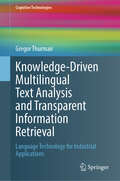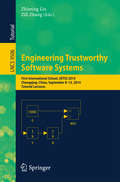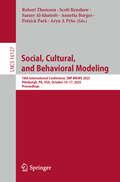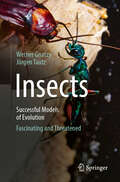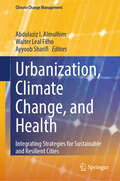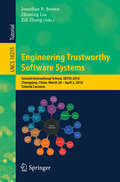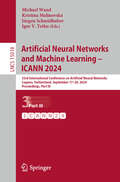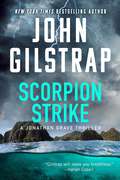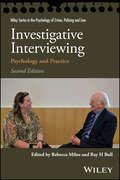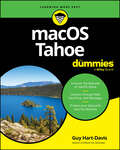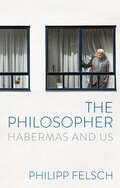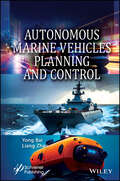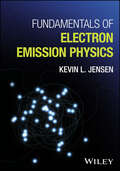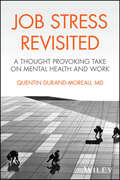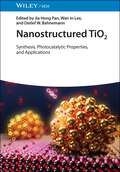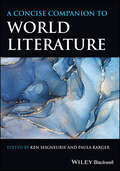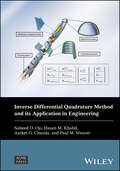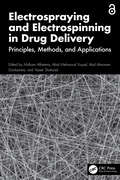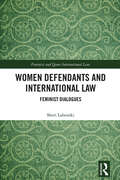- Table View
- List View
Caribbee
by Julian StockwinThe 14th volume in the popular high-seas nautical adventure series featuring naval hero Thomas Kydd. As the captain of the 32-gun frigate L'Aurore, Kydd is claimed by the Leeward Islands station, exchanging the harsh situation in South America for the warmth and delights of the Caribbean. It's a sea change for Kydd, who revisits the places and people that figured in his time as a young seaman. Some are nostalgic and pleasing, while others bring challenges of a personal nature. Even though Napoleon is triumphant on land back in Europe, Kydd and the others feel secure so far away in the Caribbean, making the most of running down prizes and sending off fat convoys of sugar to England. But, in a stroke of genius, Bonaparte finds a way to take revenge for Trafalgar, and Kydd is shocked out of complacency when an element from his past returns and he is accused of murder. In a stroke of irony, it is that same past that may just provide Kydd the means to clear his name.
War Clouds Over West Florida
by Lee GramlingJohn Thomas MacKenzie would much prefer to spend his remaining years just "tending his garden" at his estate in Spanish Florida, surrounded by his two tall sons and his lovely daughter Rebecca (whom all but her father call Becky). Unfortunately, the Empire of Great Britain and the young United States intrude on his plans. The English hope to cause an Indian uprising and seize the Spanish colony as a base for an invasion of their 13 lost American colonies. Against his will, MacKenzie is drawn into the turmoil by an American naval lieutenant and his crew who have been secretly sent by their government to try to thwart the British scheme. As if that weren't trouble enough, they encounter in the process an old enemy of MacKenzie's, a former pirate known as Dread Jamie Tyrone. When Tyrone sees Becky it's love at first sight -- on Tyrone's part. He kidnaps the young woman and plans to spirit her away to Ireland where she will be forced to become his wife. A chase ensues by both land and sea as MacKenzie and a companion seek to rescue his daughter while the Americans hurry to warn the Spaniards of the danger from the British. A resolution finally occurs at sword point in the vast untamed wilderness of Spanish West Florida.
Monet Murders (The Riley Fitzhugh Novels)
by Terry MortHollywood, 1934. Prohibition is finally over, but there is still plenty of crime for an ambitious young private eye to investigate. Though he has a slightly checkered past, Riley Fitzhugh is well connected in the film industry and is hired by a major producer—whose lovely girlfriend has disappeared. He also is hired to recover a stolen Monet, a crime that results in two murders initially, with more to come. Along the way, Riley investigates the gambling ships anchored off LA, gets involved with the girlfriend of the gangster running one of the ships, and disposes of the body of a would-be actor who assaults Riley&’s girlfriend. He also meets an elegant English art history professor from UCLA who helps Riley authenticate several paintings and determine which ones are forgeries. Riley lives at the Garden of Allah Hotel, the favorite watering place of screenwriters, and he meets and unknowingly assists many of them with their plots. Incidentally, one of these gents, whose nom de plume is &“Hobey Baker,&” might actually be F. Scott Fitzgerald.
Law and the "Sharing Economy": Regulating Online Market Platforms (Law, Technology, and Media)
by Derek McKee, Finn Makela, and Teresa ScassaLa controverse entoure les plateformes d’économie de partage, partiellement en raison de leur impact économique. Certains secteurs subissent des contrecoups de manière plus aigüe : les chauffeurs d’Uber font concurrence aux chauffeurs de taxi, ou les hôtes Airbnb rivalisent avec les hôtels. Par ailleurs, Uber exacerberait l’emploi précaire et mal rémunéré tandis qu’Airbnb amplifierait la spéculation immobilière et entraînerait, à terme, une hausse du coût de location.On a tenté de réglementer ce type de plateformes, mais la technologie est telle qu’elle permet aux entreprises d’aisément contourner la réglementation conventionnelle, si bien que les accusations de « concurrence déloyale » fusent de toutes parts, provoquant une remise en question du cadre réglementaire. En effet, de telles plateformes viennent brouiller les cartes, confondant les distinctions convenues entre personnel et commercial, infrastructure et contenu, autonomie contractuelle et contrôle hiérarchique. Cette ambiguïté peut avoir d’importantes répercussions sur le bon fonctionnement de l’appareil réglementaire qui encadre les principes organisateurs du travail, de la concurrence, de l’impôt, de l’assurance, de l’information et de de l’interdiction de la discrimination, sans parler de la réglementation sectorielle spécialisée.Cinq thématiques sont abordées dans cet ouvrage : les technologies de la réglementation; la réglementation de la technologie; les lieux de la réglementation (du local au mondial); la réglementation des marchés; et la réglementation du travail. Les chapitres se conjuguent pour offrir une réflexion d’une gamme d’experts sur la jurisprudence traditionnelle que sur les approches théoriques qui informent et façonnent la réglementation de l’économie du partage.Publié en anglais.
Knowledge-Driven Multilingual Text Analysis and Transparent Information Retrieval: Language Technology for Industrial Applications (Cognitive Technologies)
by Gregor ThurmairThis book presents all components and knowledge sources required for Transparent Information Retrieval. Depending on the respective topic and taking care of their interoperability, both deep and shallow technology is used. The processing starts from the analysis of the text data and collects its results in a multilingual conceptual network, this way enabling Transparent Information Retrieval where users communicate with the system in their native language while the documents could be in a different language, transparent to the users. To do so, the author investigates all text analysis components required for multilingual indexing, starting from preparatory work like language and topic identification, continuing with sentence splitting and tokenization (including Chinese), and describing lexical analysis, also for multiword entries and Named Entities. Entries are then disambiguated both on syntactic (by a tagger) and semantic level (by multilingual word sense disambiguation). The analysis results are collected in a dynamic multilingual ConceptNet, which is an index structure extended by monolingual relations (like synonyms, or head-modifier links) as well as multilingual ones (translations). In addition to many European languages also Turkish, Arabic, Persian, and Chinese are treated. The book concludes with a description of components needed to build the required resources, like crawlers, bilingual term extraction, and tools for defaulting linguistic annotations. For each component, readers will find a technology overview, a discussion of its main challenges in computational treatment, a description of the technical solution selected, and evaluation information.
Engineering Trustworthy Software Systems: First International School, SETSS 2014, Chongqing, China, September 8-13, 2014. Tutorial Lectures (Lecture Notes in Computer Science #9506)
by Zhiming Liu Zili ZhangThis volume contains the lecture notes of the five courses and one seminar given at the School on Engineering Trustworthy Software Systems (SETSS 2014), held in September 2014 at Southwest University in Chongqing, China. The material is useful for postgraduate students, researchers, academics and industrial engineers who are interested in the theory and practice of methods and tools for the design and programming of trustworthy software systems. The common themes of the courses include the design and use of theories, techniques and tools for software specification and modeling, analysis and verification. The courses cover sequential programming, component- and object software, hybrid systems and cyber-physical systems with challenges of termination, security, safety, security, fault-tolerance and real-time requirements. The techniques include model checking, correctness by construction through refinement and model transformations, synthesis and computer algebra.
Reconciliation, Heritage and Social Inclusion in the Middle East and North Africa
by Martin Leiner Iyad Muhsen AlDajaniThis book, sponsored by the Academic Alliance for Reconciliation Studies in the Middle East and North Africa (AARMENA), focuses on peacebuilding, conflict transformation, and shifts toward approaching the reconciliation process as an inter-, trans- and multidisciplinary field. The research presented in the series focuses on the Middle East and North Africa, highlighting contributions by practitioners and scholars alike. This volume showcases research on Heritage, Reconciliation, and Social Inclusion in the Middle East and North Africa. It reflects various inter-, trans- and multidisciplinary approaches applied both theoretically and practically, and explores conflict transformation and transitional shifts towards peacebuilding and reconciliation in the MENA (Middle East and North Africa) region. The content is divided into five sections, the first of which examines the importance of reconciliation, peacebuilding, and social inclusion in contributions by experts in the field such as Martin Leiner, Wolfgang Dietrich, Mohammad Abu Nimer, Mohmmad Alshraideh and Iyad Aldajani. The second and third section explore digital humanities and the research sciences respectively, while the fourth turns to practices of heritage and reconciliation. The fifth section presents case studies on practices, conducted by expert researchers for heritage, reconciliation, and social inclusion in higher education.
Social, Cultural, and Behavioral Modeling: 18th International Conference, SBP-BRiMS 2025, Pittsburgh, PA, USA, October 14–17, 2025, Proceedings (Lecture Notes in Computer Science #16127)
by Robert Thomson Scott Renshaw Samer Al-Khateeb Annetta Burger Patrick Park Aryn A PykeThis volume contains the proceedings of the 18th International Conference on Social, Cultural, and Behavioral Modeling, SBP-BRiMS 2025, which took place in Pittsburgh, Pennsylvania, USA, in October 2025. The 23 papers presented in this volume were carefully reviewed and selected from 56 submissions. They are divided into the following themes: Advances in Tools and Theory; Data-Driven Approaches. Another focus of the conference is on understanding, predicting, and influencing human sociocultural behavior.
Insects - Successful Models of Evolution: Fascinating and Threatened
by Jürgen Tautz Werner GnatzyIn the course of evolution, insects have developed an almost unbelievable variety of shapes and functional sophistication. The design of their exoskeleton is so imaginative and unusual, often even bizarre, that one can only marvel. The fact that insects can find design solutions for any problem, no matter how special, makes them extremely successful. They have thus become crucial links in the complex networks of nature. Impressive macro photographs and informative scanning electron-optical images provide an insight into the wealth of forms, beauty and function of the six-legged creatures. Fascinating texts accompany the pictures and explain, among other things, how the great diving beetle uses vertebrate hormones as knock-out drops when attacked by fish, the pine moth beetle locates distant forest fires, the bombardier beetle emits pulsed explosions with its firing apparatus or the blue butterfly caterpillar glamours ants. Insects play a crucial role in the ecosystems of our planet. Man-made environmental destruction is interfering with these cycles in a sensitive way. This endangers the survival of insects, with dramatic consequences for us humans as well.
Urbanization, Climate Change, and Health: Integrating Strategies for Sustainable and Resilient Cities (Climate Change Management)
by Walter Leal Filho Ayyoob Sharifi Abdulaziz I. AlmulhimThis book seeks to provide a comprehensive examination of the critical intersection between urbanization, climate change, and public health. As urban areas expand and face increasing pressures from environmental changes and population growth, there is a growing need for integrated approaches that address these intertwined challenges. This book aims to explore how urban planning, public health, and climate resilience can be aligned to create cities that are not only sustainable but also capable of supporting the well-being of their residents. Designed as a vital resource for urban planners, public health professionals, policymakers, environmentalists, and academics, this book offers insights into strategies for fostering urban environments that can adapt to climate-related challenges while enhancing public health. It covers a wide range of topics, including the design of resilient infrastructure, the creation of green spaces, sustainable urban mobility, and the role of governance and policy in promoting urban health. Additionally, this book emphasizes the importance of community engagement and ethical considerations in urban planning processes. The primary objective is to present a multidisciplinary approach to urban development that addresses the interconnected issues of climate change and public health. By integrating case studies, best practices, and innovative strategies, this book seeks to equip readers with the tools needed for informed decision-making and strategic planning. Ultimately, it aims to inspire the creation of urban spaces that are not only resilient and sustainable but also inclusive and health-promoting, ensuring that cities can thrive in the face of future challenges.
Engineering Trustworthy Software Systems: Second International School, SETSS 2016, Chongqing, China, March 28 - April 2, 2016, Tutorial Lectures (Lecture Notes in Computer Science #10215)
by Jonathan P. Bowen Zhiming Liu Zili ZhangThis volume contains a record of some of the lectures and seminars delivered at the Second International School on Engineering Trustworthy Software Systems (SETSS 2016), held in March/April 2016 at Southwest University in Chongqing, China.The six contributions included in this volume provide an overview of leading-edge research in methods and tools for use in computer system engineering. They have been distilled from six courses and two seminars on topics such as: modelling and verification in event-B; parallel programming today; runtime verification; Java in the safety-critical domain; semantics of reactive systems; parameterized unit testing; formal reasoning about infinite data values; and Alan Turing and his remarkable achievements. The material is useful for postgraduate students, researchers, academics, and industrial engineers, who are interested in the theory and practice of methods and tools for the design and programming of trustworthy software systems.
Artificial Neural Networks and Machine Learning – ICANN 2024: 33rd International Conference on Artificial Neural Networks, Lugano, Switzerland, September 17–20, 2024, Proceedings, Part III (Lecture Notes in Computer Science #15018)
by Igor V. Tetko Jürgen Schmidhuber Michael Wand Kristína MalinovskáThe ten-volume set LNCS 15016-15025 constitutes the refereed proceedings of the 33rd International Conference on Artificial Neural Networks and Machine Learning, ICANN 2024, held in Lugano, Switzerland, during September 17–20, 2024. The 294 full papers and 16 short papers included in these proceedings were carefully reviewed and selected from 764 submissions. The papers cover the following topics: Part I - theory of neural networks and machine learning; novel methods in machine learning; novel neural architectures; neural architecture search; self-organization; neural processes; novel architectures for computer vision; and fairness in machine learning. Part II - computer vision: classification; computer vision: object detection; computer vision: security and adversarial attacks; computer vision: image enhancement; and computer vision: 3D methods. Part III - computer vision: anomaly detection; computer vision: segmentation; computer vision: pose estimation and tracking; computer vision: video processing; computer vision: generative methods; and topics in computer vision. Part IV - brain-inspired computing; cognitive and computational neuroscience; explainable artificial intelligence; robotics; and reinforcement learning. Part V - graph neural networks; and large language models. Part VI - multimodality; federated learning; and time series processing. Part VII - speech processing; natural language processing; and language modeling. Part VIII - biosignal processing in medicine and physiology; and medical image processing. Part IX - human-computer interfaces; recommender systems; environment and climate; city planning; machine learning in engineering and industry; applications in finance; artificial intelligence in education; social network analysis; artificial intelligence and music; and software security. Part X - workshop: AI in drug discovery; workshop: reservoir computing; special session: accuracy, stability, and robustness in deep neural networks; special session: neurorobotics; and special session: spiking neural networks.
Scorpion Strike (A Jonathan Grave Thriller #10)
by John GilstrapAn island paradise is taken hostage in a plot to spark global war in this &“perfect summer read for thriller fans&” by the New York Times bestselling author (Publishers Weekly, starred review). For Jonathan Grave and Gail Bonneville, the Crystal Sands Resort just off Mexico&’s Pacific coast is the perfect getaway—until gunshots shatter the night. Wealthy guests are yanked out of their rooms and forced to submit to their captors&’ demands. But Grave and Bonneville are no ordinary vacationers. The Russian mercenaries who invade their bungalow receive a deadly surprise. And the two skilled operatives escape into the jungle. It won&’t be long before the invaders turn this tropical paradise into a powder keg that will set off global chaos. Grave may be without weapons—and cut off from his usual tactical team—but he&’s never without resources. Bold action is the only solution. Like the scorpion, Grave must strike fast and hard.
Investigative Interviewing: Psychology and Practice (Wiley Series in Psychology of Crime, Policing and Law)
by Rebecca Milne Ray H Bull“Professors Milne and Bull have produced an updated magnus opus of the science of investigative interviewing. It is not only an indispensable substitute for the cruelty of torture and coercion in solving crime, as this volume demonstrates, it is also a much more effective way of establishing the truth and assigning responsibility, which is the only legitimate object of criminal investigations.” —JUAN E. MENDEZ, Former UN Special Rapporteur on Torture (2010-2016) “Investigative Interviewing: Psychology and Practice (1999) was nothing short of the clearest, most comprehensive approach on how to effectively interview in a criminal context while adhering to the highest possible ethical principles. Milne and Bull are back with a new edition of their landmark text, updating it to include, as contributors, many of the scholars who have been influenced by the original. This edition is sure to inspire another generation of practitioners and researchers to pursue truth and justice in investigative interviews.” —CHRISTOPHER E. KELLY, PhD, Professor of Criminal Justice, Saint Joseph’s University (USA), Co-Director, International Investigative Interviewing Research Group “This second edition of Investigative Interviewing: Psychology and Practice is a rare achievement. The Editors have brought together a stellar group of contributors to create more than a textbook: it’s a bridge between research and the realities of investigative work. This is a vital resource for anyone committed to ethical and effective investigations: one that informs, challenges and ultimately helps improve the way investigations are conducted.” —PAULO BARBOSA MARQUES, Inspector, Polícia Judiciária Become a well-informed and skilled investigative interviewer In the newly revised second edition of Investigative Interviewing: Psychology and Practice, a team of distinguished forensic psychologists and practitioners deliver an up-to-date and practical guide to the psychological concepts and evidence-based research that underpin and inform investigative interviewing. The editors have included works that examine the foundational skills and processes that make up the ethical interviewing of witnesses, victims, and those suspected of crime. Each chapter is written by a group of contributors who are leaders in their field. Readers will also find: A thorough introduction to the principles of memory formation and their implications for investigative interviewingComprehensive explorations of the cognitive interview, and examination concerning how to help those who are deemed vulnerable, with complex needs, to give reliable informationPractical discussions of how to manage conversations, detect truth/deceit, and develop rapport-based interpersonal techniquesFulsome treatments of how to convince members of an investigative organisation to adopt the techniques and strategies discussed in the book. Perfect for aspiring and practicing professionals engaged in the interviewing of participants in the criminal justice and investigation processes, Investigative Interviewing: Psychology and Practice will also benefit solicitors, barristers, social workers, and judges with an interest in the art and science of interviewing.
macOS Tahoe For Dummies
by Guy Hart-DavisGet up to speed on the latest macOS updates and features macOS Tahoe For Dummies is your up-to-date guide to the operating system that brings your Mac computer to life. Experienced macOS expert and educator Guy Hart-Davis walks you through a comprehensive set of instructions for navigating your Mac's features and capabilities. Whether you've just jumped on the Mac bandwagon or you're a long-time Apple user, you'll benefit from the step-by-step walkthroughs of how to organize your files and photos, connect with friends using Messages and FaceTime, and securing your data against external threats and accidental loss. Navigate the new Liquid Glass interface and organize files and media Listen to music, watch movies, and enjoy your photos Use powerful macOS system tools Troubleshoot common issues that macOS users run into and learn how to get support Protect yourself against hackers, phishing attacks, and other dangers macOS Tahoe For Dummies is the essential guide for new and experienced Mac users looking to get the most out of their macOS-powered computer and take advantage of the latest features and updates Apple has packed into macOS Tahoe.
The Philosopher: Habermas and Us
by Philipp FelschJürgen Habermas is the voice of a generation. One of the world’s most influential philosophers and Germany’s greatest living intellectual, he has shaped debates, both academic and public, for more than half a century. For as long as the cultural historian Philipp Felsch can remember, Habermas has been around: as an admonishing voice of reason, as the moral conscience of post-Holocaust German society, as the son of his grandparents’ neighbours in Gummersbach. Is the philosopher's intellectual supremacy coming to an end today, or are his ideas gaining new relevance in the crisis times in which we now find ourselves?To answer this question, Felsch plunged anew into Habermas’s voluminous work and travelled to his home to talk with him over tea and cake about the concerns that have motivated him, the people who have influenced him and the controversies in which he has been involved. Can the ideas that the philosopher has championed throughout his career – universalism, reason, dialogue – be of any help to us now as we face the major challenges of the twenty-first century?This compelling account of a strikingly original thinker is also a portrait of an epoch that bears his imprint and a glimpse of a future we could embrace.
Autonomous Marine Vehicles Planning and Control
by Liang Zhao Yong BaiMaster the future of marine exploration and technology with Autonomous Marine Vehicles Planning and Control, which provides a comprehensive, interdisciplinary guide to the principles, control, and real-world applications of autonomous marine vehicles. Autonomous Marine Vehicles Planning and Control explores the intricate and rapidly evolving field of autonomous marine vehicles, focusing on unmanned surface vehicles (USVs) and autonomous underwater vehicles (AUVs). This book is designed to provide a comprehensive overview of the fundamental principles, advanced control methodologies, and practical applications of these autonomous systems in various marine environments. Through a series of detailed chapters, the book delves into the technical aspects, innovative algorithms, and real-world challenges associated with the deployment and operation of USVs and AUVs. Through a highly technical and research-oriented approach, each chapter combines theoretical analysis with practical case studies and simulation results to illustrate the effectiveness of the proposed methods. The book also addresses the interdisciplinary nature of the field, integrating concepts from robotics, artificial intelligence, and marine engineering to provide a holistic view of autonomous marine vehicle technology.
Autonomous Flying Ad-Hoc Networks
by Adarsh Kumar Keshav Kaushik Saurav Mallik Taskeen ZaidiLearn to leverage the power of Autonomous Flying Ad-Hoc Networks (FANETs) for everything from urban surveillance to disaster relief, and stay ahead in the rapidly evolving world of drone technology and AI. Flying ad-hoc networks (FANETS) are emerging as an innovative technology in the Unmanned Aerial Vehicles (UAV) space, which has proven its usefulness in urban surveillance, disaster management, and rescue operations. In FANETs, a swarm of UAVs are locally connected together through a base station and the nearby environment to gather the information. FANETs are able to cover larger distances than its predecessors, MANETs (Mobile Ad-hoc Networks) and VANETs (Vehicle Ad-Hoc Networks), making them an ideal solution for gathering vital data. As artificial intelligence is implemented across a number of industries, this technology has the capability to train large datasets. Researchers are exploring ways to improve AI algorithms and quantum computing using this technology. Autonomous Flying Ad-Hoc Networks offers comprehensive coverage of the fundamentals of FANET technology by comparing the differences between FANETs, MANETs, and VANETs, including their characteristics, features, and design models, and discussing the applications and challenges of FANET adoption.
Fundamentals of Electron Emission Physics
by Kevin L. JensenAn authoritative and accurate guide to the physics of research- and technology-relevant phenomena of electron emission In Fundamentals of Electron Emission Physics, distinguished research physicist, Dr. Kevin Jensen, delivers a practice-oriented introduction to the physics of electron emission. The book uses a physical intuition approach based on many years of research instead of heavy-handed mathematical formalism. The author explores and explains the fundamentals of electron emission and the basis for successful performance and interpretation of experiments conducted at lab- and large-scale electron sources. He addresses the most common stumbling blocks that students and researchers who are new to the field often run into when confronted with the intricacies of the physics of electron emission. Thorough introductions to semiconductors, canonical emission models, and modern physics methodsComprehensive explorations of tunneling and transmission, the thermal-field-photoemission model, three-step models of photo- and secondary emission, and space chargePractical discussions of mathematical methods and specialized functions (e.g., Gamma function, Riemann Zeta function, orthogonal polynomials)A mathematical appendix, as well as sample problems and solutions to help explain the topics discussed in the book Perfect for advanced undergraduate and doctoral students in solid state physics, materials science, electron transport, and beam physics, Fundamentals of Electron Emission Physics will also benefit users and developers of electron sources and practicing academics and researchers.
Job Stress Revisited: A Thought Provoking Take on Mental Health and Work
by Quentin Durand-MoreauProvides a comprehensive framework for understanding mental health in the workplace Job Stress Revisited: A Thought Provoking Take on Mental Health and Work offers a critical and much-needed re-evaluation of how job stress is understood, addressed, and managed in modern workplaces. In contrast to popular narratives that individualize stress and recommend surface-level interventions, this resource challenges these assumptions by locating job stress within the very structure and nature of work itself. Drawing on more than a decade of clinical and academic experience, the author underscores how workplace environments and policies—not personal shortcomings—are often the true sources of stress-related mental health issues. Empowering readers to become informed advocates for lasting change, the book offers a multi-dimensional exploration of job stress, informed by biological, epidemiological, and activity-centered approaches. A structured three-part format builds from foundational concepts to actionable solutions, first clearly defining essential concepts—work, health, and their intersections—before delving into critical issues such as burnout, harassment, toxic workplace dynamics, and substance use. In the final section, Durand-Moreau calls for systemic change, advocating for robust policies, workplace inspections, and structural reform rather than temporary fixes. A practical guide for those who seek to make work environments healthier and more equitable, Job Stress Revisited: A Thought Provoking Take on Mental Health and Work: Challenges prevailing wellness narratives by shifting focus from individuals to systemic workplace factors Integrates clinical insights from over 400 work-related mental health cases Offers a comparative international perspective, especially from Canadian and French occupational health systems Combines theoretical analysis with practical case studies to enhance accessibility Explores lesser-addressed topics such as doping at work With vivid case studies and accessible illustrations throughout, Job Stress Revisited: A Thought Provoking Take on Mental Health and Work is essential reading for graduate and professional-level courses such as Occupational Health, Work Psychology, Organizational Behavior, and Public Health Policy. It is ideal for degree programs in Occupational Medicine, Human Resources, Public Health, and Industrial-Organizational Psychology as well as working professionals like union reps, HR, and any worker interested in this topic.
Nanostructured TiO2: Synthesis, Photocatalytic Properties, and Applications
by Detlef W. Bahnemann Wan In Lee Jiahong PanComprehensive reference on TiO2 materials, from fundamentals to widely used areas such as water purification and solar fuel generation With in-depth analysis and coverage, Nanostructured TiO2 is an advanced reference on the subject, offering techniques, characterizations, and novel approaches to titanium dioxide (TiO2) nanostructures. The book incorporates cutting-edge research findings and innovations in the synthesis and utilization of TiO2 nanostructures. From environmental remediation and renewable energy to biomedical applications and advanced materials science, this book provides insights into how these materials are transforming a wide range of industries. In addition to theory and research, the book provides practical insights including real-world case studies, experimental protocols, and problem-solving techniques. Nanostructured TiO2 includes information on: Controllable synthesis of zero- to three-dimensional TiO2 nanostructures, immobilization of TiO2 on various substrates, and surface modification of TiO2 Photocatalytic fixed-bed reactions for efficient photon utilization of TiO2 and carrier transport and recombination in sensitized nanostructured TiO2 Type, characterization, and activity of TiO2-based heterojunction photocatalysts Application of TiO2 for the photocatalytic conversion of nitrogen oxides NO and NO2 Recycling of heavy metal ions from wastewater by TiO2 photocatalysis Nanostructured TiO2 is an essential up-to-date reference for inorganic chemists, catalytic chemists, materials scientists, photochemists, and professionals in the sensor industry seeking state-of-the-art knowledge on the subject.
A Concise Companion to World Literature
by Ken Seigneurie Paula KargerProvides a student-friendly introduction to World Literature Bridging the gap between introductory materials and advanced scholarly research, the Concise Companion to World Literature offers a streamlined selection of the most popular and essential essays from The Companion to World Literature, specifically tailored for undergraduate students and instructors. This single-volume resource, edited by Ken Seigneurie and Paula Karger, presents 100 carefully curated chapters, fully revised for clarity and accompanied by newly commissioned essays. The Concise Companion, which retains the original work's three-tiered organizational structure—period essays, thematic bridge essays, and author-title chapters—offers a nuanced exploration of major literary traditions across time and geography. Each entry contextualizes major literary works within the broader framework of global literary traditions, enriching discussions on periodization, literary movements, and cross-cultural connections. With its accessible scholarship and enhanced learning tools, it is a vital resource for students beginning their journey in World Literature and for educators seeking a structured, easy-to-use reference. Providing an engaging approach to the vast landscape of global literary traditions, the Concise Companion to World Literature: Features an entirely new introductory section that offers contemporary perspectives on World Literature Showcases a diverse array of global texts, authors, and traditions to deliver a broad and inclusive literary perspective Addresses key debates in World Literature, including periodization, cross-cultural exchange, and literary historiography Includes a new pedagogical supplement to assist instructors in course design and aid students in literary analysis The Concise Companion to World Literature, designed for second- and third-year undergraduate students, is an essential resource for courses in World Literature, Comparative Literature, and Humanities programs. It is also a valuable tool for graduate students and faculty seeking an authoritative and easy-to-use reference for teaching and research in the field.
Inverse Differential Quadrature Method and its Application in Engineering (Wiley-ASME Press Series)
by Saheed O. Ojo Hasan M. Khalid Aniket G. Chanda Paul M. WeaverInverse Differential Quadrature Method and its Application in Engineering Authoritative reference introducing iDQM as a numerical tool to accurately perform high fidelity analyses efficiently for solving problems in engineering governed by higher-order ordinary and partial differential equations. Inverse Differential Quadrature Method and its Application in Engineering is the first book to comprehensively cover the development of a new numerical solution technique: the inverse differential quadrature method (iDQM), as an indirect approximation technique that can circumvent numerical differentiation-induced errors in the solution of systems of higher-order differential equations. The book’s introduction highlights the historical development of numerical methods in the field while emphasising the significance of strong-form solution methods. Detailed derivations of iDQM formulations in one- and two-dimensions, approximation procedures, and error quantification are described. The subsequent chapters describe the application of iDQM to many fields of engineering including structures, heat flow, fluids, waves and multiphysics problems. Example applications covering linear and nonlinear systems are demonstrated with simple and detailed discretisation steps to aid reader understanding of iDQM. MATLAB codes for many of the illustrative examples in the book are provided to ease implementation and practice for readers. Written by a team of highly qualified academics, Inverse Differential Quadrature Method and its Application in Engineering discusses topics including: High fidelity linear and non-linear structural analyses of variable-stiffness curved beams, arbitrary-shaped plates, and cylindrical and spherical shells governed by unified formulation kinematicsiDQM error formulation and its effect on spectral convergenceAccurate and efficient solutions of non-structural problems governed by, for example, Korteweg-de Vries (KdV) wave, Helmholtz, convection-diffusion and steady state heat conduction equations and nonlinear one- and two-dimensional scalar combustion modelsStrategies to alleviate mathematical ill-conditioning of system matrices employing novel preconditioning techniques Inverse Differential Quadrature Method and its Application in Engineering is an essential reference for researchers and engineers performing advanced numerical analysis across a range of applications in the mechanical, aerospace, chemical, and civil engineering industries, along with graduate students in related programs of study.
Electrospraying and Electrospinning in Drug Delivery: Principles, Methods, and Applications
by Yasser Shahzad Abid Mehmood Yousaf Mulham Alfatama Abd Almonem DoolaaneaElectrospraying and electrospinning have emerged as powerful techniques for the fabrication of drug-loaded nano- and microstructures, offering precise control over particle size, morphology, and drug release kinetics. Electrospraying and Electrospinning in Drug Delivery provides a comprehensive overview of the principles and latest advancements, methodologies, and applications of electrospraying and electrospinning techniques in the field of drug delivery. It encompasses a wide array of topics, including but not limited to targeted drug delivery systems, controlled release formulations, stimuli-responsive materials, and biomedical applications.• Describes the most recent and successful applications of electrospraying/electrospinning in drug delivery• Covers fundamental principles, instrumentation, process parameters, and optimization strategies• Delves into the diverse range of materials employed in electrospraying and electrospinning, such as polymers, ceramics, and metals, highlighting their unique advantages and applications in drug delivery• Explores the incorporation of functional additives, such as nanoparticles and biomolecules, to tailor the properties and performance of electrospun/electrosprayed drug delivery platformsBy compiling contributions from leading experts in the field, this edited volume fosters interdisciplinary collaboration and inspires further research endeavors. The book will serve as a valuable resource for researchers, academicians, and professionals interested in understanding and utilizing these innovative techniques for enhanced drug delivery systems.
Women Defendants and International Law: Feminist Dialogues (Feminist and Queer International Law)
by Sheri LabenskiThis book addresses the largely neglected place of women defendants in contemporary international criminal law, beyond the construction of women as victims, and asks what the analysis of women perpetrators, defendants and suspects reveals about international criminal law, the media and feminism.The book uses the topic of women perpetrators, defendants and suspects as a way to explore the concept of legal subjectivity via a gender analysis. It highlights how women perpetrators, defendants and suspects are constituted through three spheres, namely the areas of international criminal law, the media and feminism. In examining the relationship between women perpetrators, defendants and suspects and each of these spheres, the book exposes embedded gender biases and structural gender fractures. These reveal that problematic assumptions about how gender operates in conflict are embedded in the very foundations of legal imaginations. Ultimately, the book argues that this has far reaching consequences, beyond its impact on current understandings of armed conflict. Rather, these assumptions should be a concern for us all, even in times of peace.This book will be of use to legal academics and practitioners interested in gender within international criminal law, as well as those concerned with contemporary feminist approaches to law.
